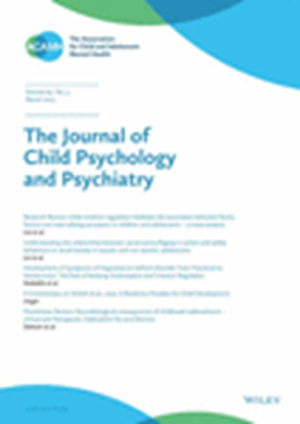Examining systemic inflammation as a pathway linking peer victimization to depressive symptoms in adolescence
IF 6.5
1区 医学
Q1 PSYCHIATRY
引用次数: 0
Abstract
BackgroundAdolescents exposed to victimization are at an increased risk for a variety of adverse mental health outcomes, including depressive symptoms. Yet, the biological pathways underlying these associations remain poorly understood. Focusing on within‐person processes, we examined whether low‐grade systemic inflammation mediated the longitudinal associations between peer victimization and depressive symptoms in adolescence.Methods207 adolescents (at baseline研究全身性炎症是青春期同伴伤害与抑郁症状之间的联系途径
背景受到伤害的青少年出现各种不良心理健康后果(包括抑郁症状)的风险增加。然而,人们对这些关联的生物学途径仍然知之甚少。方法207名青少年(基线年龄Mage = 12.69岁;SD = 0.49;43.5%为女性)参加了一项多波纵向研究,在1年半的时间里每6个月重复一次评估。在每次评估中,参与者都会自我报告其同伴受害经历和抑郁症状。在每次评估时,研究人员都会采用刺破手指的方法采集干血斑,以检测低度全身炎症的主要标志物白细胞介素-6(IL-6)。结果从IL-6到抑郁症状的交叉滞后路径在所有模型和波次中都是显著的(β12 = .13;β23 = .12;β34 = .08),这表明当青少年的低级全身炎症水平高于其特定人群的平均水平时,他们在随后几个月中的抑郁症状水平就会增加。然而,在同伴受害与 IL-6 或抑郁症状之间并没有出现明显的交叉滞后人际关联。尽管如此,研究结果表明,低度全身炎症水平的升高可预测青少年抑郁症状的发展,从而扩展了之前的研究。
本文章由计算机程序翻译,如有差异,请以英文原文为准。
求助全文
约1分钟内获得全文
求助全文
来源期刊
CiteScore
13.80
自引率
5.30%
发文量
169
审稿时长
1 months
期刊介绍:
The Journal of Child Psychology and Psychiatry (JCPP) is a highly regarded international publication that focuses on the fields of child and adolescent psychology and psychiatry. It is recognized for publishing top-tier, clinically relevant research across various disciplines related to these areas. JCPP has a broad global readership and covers a diverse range of topics, including:
Epidemiology: Studies on the prevalence and distribution of mental health issues in children and adolescents.
Diagnosis: Research on the identification and classification of childhood disorders.
Treatments: Psychotherapeutic and psychopharmacological interventions for child and adolescent mental health.
Behavior and Cognition: Studies on the behavioral and cognitive aspects of childhood disorders.
Neuroscience and Neurobiology: Research on the neural and biological underpinnings of child mental health.
Genetics: Genetic factors contributing to the development of childhood disorders.
JCPP serves as a platform for integrating empirical research, clinical studies, and high-quality reviews from diverse perspectives, theoretical viewpoints, and disciplines. This interdisciplinary approach is a key feature of the journal, as it fosters a comprehensive understanding of child and adolescent mental health.
The Journal of Child Psychology and Psychiatry is published 12 times a year and is affiliated with the Association for Child and Adolescent Mental Health (ACAMH), which supports the journal's mission to advance knowledge and practice in the field of child and adolescent mental health.

 求助内容:
求助内容: 应助结果提醒方式:
应助结果提醒方式:


